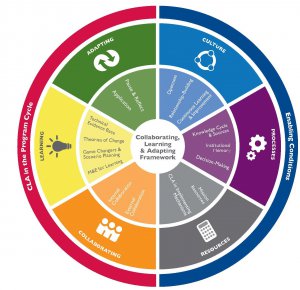 This podcast focuses on the adaptation component of CLA at the project and organizational levels.
This podcast focuses on the adaptation component of CLA at the project and organizational levels.
The first segment of the episode follows a program focused on capacity building of local staff. Real-time monitoring and continuous analysis of the project achievements against targets/ objectives enabled timely decision-making and pivoting the approach from a traditional training model to one that matched local consultants with local companies. Critical to this adaptation was the trust between the donor and implementing partner which provided the implementing partner the flexibility to change course when the project results were not meeting expectations.
The second segment focused on how processes and ensuring feedback loops can facilitate adaptation. Though the design of the “Jordan Gender Programme” was centered on providing the space for social dialogue around gender issues within the community, with the notion that the community would then implement solutions emanating from the discussions, community feedback showed this approach was not successful. In response, the organization adapted in two ways:
- Firstly, the implementing partner adjusted their activities themselves to better engage the affected people themselves in identifying the threats, vulnerabilities, and capacities which exist within the community. By restructuring the approach that the organization used to solicit feedback and concerns from the affected people, the analysis revealed that women did not have access to safe transportation, making economic participation impossible. By disaggregating risk patterns, the project was able to create a campaign to address the needs of the population.
- Secondly, based on needs prioritization from community members, the organization integrated grantmaking into their program design and resource mobilization efforts. The integration of grantmaking by offering opportunities for small grants to fund community initiatives undertaken by CBOs enables a design for contribution approach, whereby a multitude of actors at different levels can leverage their relevant capacities and entry points to solve the identified protection concerns.
The final segment follows a resilience project in the Sahel that intentionally planned adaptive activities from the outset of the project. By bringing partners implementing complementary resilience projects together to look at existing resilience best practices accompanied by coordinated joint site visits, the project was able to create a space for peer to peer learning and find new ways to collaborate. Some key takeaways relevant to RBP include:
- A focus on adaptation from the outset, ensuring that flexibility and adaptability underpin every aspect of the response, demonstrates a focus on outcome-oriented methods.
- Multi-Disciplinary Strategies is emphasized by allowing for constant adaptation and thus demonstrating a conscious effort to cultivate complementarity between all relevant actors.
Finally, as a running thread across the examples cited, trust amongst partners, donors, and community members was key to the adaptation. Whether through funding requirements, or mapping stakeholder contributions and resources, or building relationships with affected communities themselves at the foundation – trust is a precondition to developing an agile response suitable for the context.